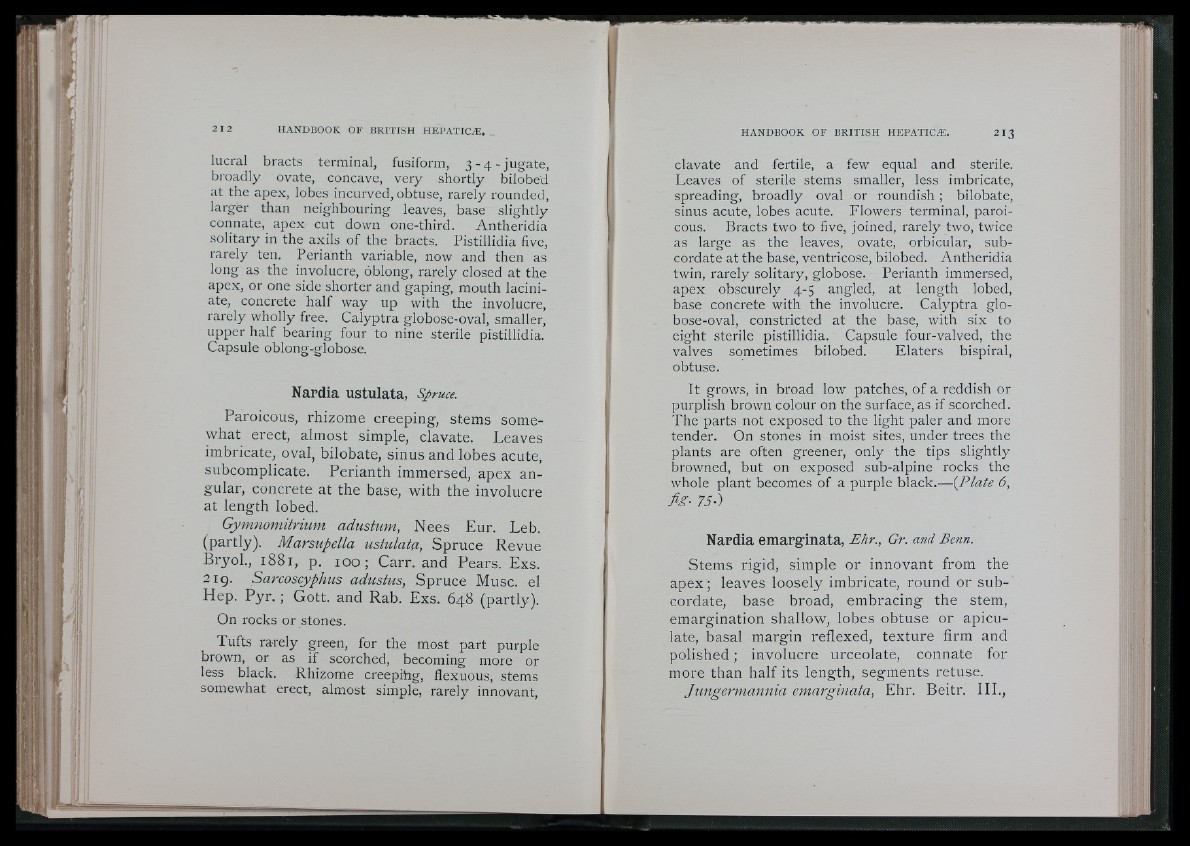
% ^■î
lucral bracts terminal, fusiform, 3 - 4 -jugate,
broadly ovate, concave, very shortly bilobed
at the apex, lobes incurved, obtuse, rarely rounded,
larger than neighbouring leaves, base slightly
connate, apex cut down one-third. Antheridia
solitary in the axils of the bracts. Pistillidia five,
rarely ten. Perianth variable, now and then as
long as the involucre, oblong, rarely closed at the
apex, or one side shorter and gaping, mouth laciniate,
concrete half way up with the involucre,
rarely wholly free. Calyptra globose-oval, smaller,
upper half bearing four to nine sterile pistillidia.
Capsule oblong-globose.
Nardia ustulata, Spruce.
Paroicous, rhizome creeping, stems somewhat
erect, almost simple, clavate. Leav e s
imbricate, oval, bilobate, sinus and lobes acute,
subcomplicate. Per ianth immersed, apex angular,
concrete at the base, with the involucre
at length lobed.
Gymnomitrium adustum, Nees Eur. Leb.
(partly). Marsupella ustulata, S p ru c e Re vue
Bryol., 1881, p. 10 0 ; Carr, and Pears. Exs.
2 ig . Sarcoscyphus adustus, Sp ru c e Muse, el
Hep. P y r . ; Gott. and Rab. Exs. 648 (partly).
On rocks or stones.
Tufts rarely green, for the most part purple
brown, or as if scorched, becoming more or
less black. Rhizome creepihg, flexuous, stems
somewhat erect, almost simple, rarely innovant.
IÎ jIi; ■.'s.'1 f
clavate and fertile, a few equal and sterile.
Leaves of sterile stems smaller, less imbricate,
spreading, broadly oval or roundish ; bilobate,
sinus acute, lobes acute. Flowers terminal, paroicous.
Bracts two to five, joined, rarely two, twice
as large as the leaves, ovate, orbicular, sub-
cordate at the base, ventricose, bilobed. Antheridia
twin, rarely solitary, globose. Perianth immersed,
apex obscurely 4-5 angled, at length lobed,
base concrete with the involucre. Calyptra globose
oval, constricted at the base, with six to
eight sterile pistillidia. Capsule four-valved, the
valves sometimes bilobed. Elaters bispiral,
obtuse.
It grows, in broad low patches, of a reddish or
purplish brown colour on the surface, as if scorched.
The parts not exposed to the light paler and more
tender. On stones in moist sites, under trees the
plants are often greener, only the tips slightly
browned, but on exposed sub-alpine rocks the
whole plant becomes of a purple black.— {Plate 6,
fig- 7S-)
Nardia emarg-inata, Ehr., Gr. and Benn.
Stems rigid, simple or innovant from the
apex ; leaves loose ly imbricate, round or sub-
cordate, base broad, embrac ing the stem,
emarginat ion shallow, lobes obtuse or apiculate,
basal margin reflexed, texture firm and
polished ; involucre urceolate, connate for
more than half its length, segments retuse.
Jungermannia emarginata, Ehr. Beitr. III.,
■ I '« .I
‘M
11
I
i l
i"
«